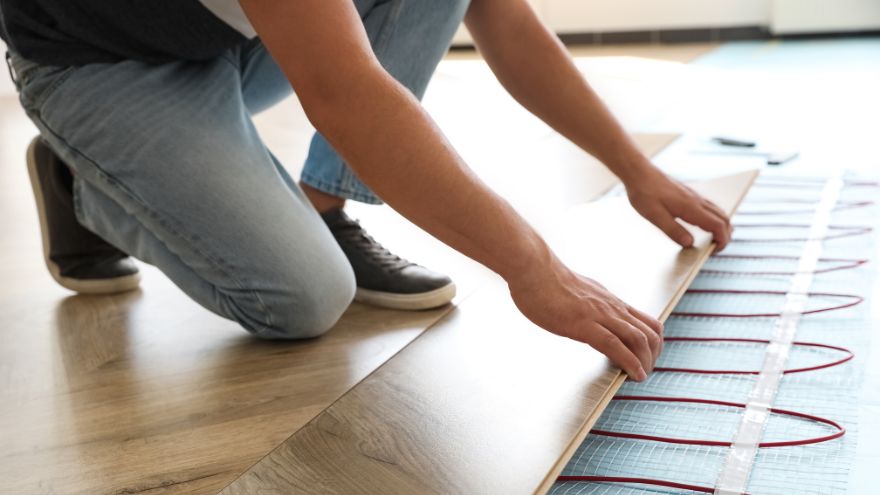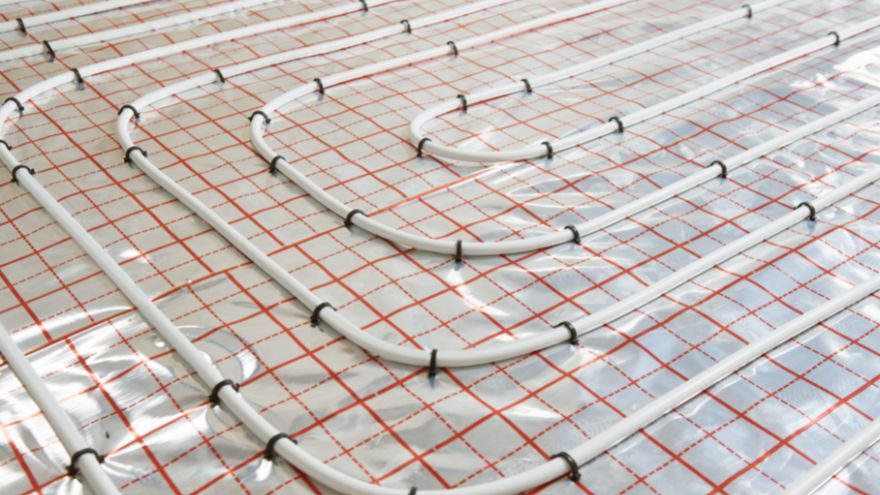In modern interiors, where traditional radiators are not always effective, heating cables are increasingly installed under the floor. The most commonly used solutions are underfloor heating or trench heaters, and sometimes a combination of these systems. Today we will focus on comparing them, pointing out the characteristic features, advantages and disadvantages of both.

From this article you will learn:
- How do underfloor heating and trench heaters work?
- What are the advantages and disadvantages of these heating systems?
- Where do each of them work best?
- What should you pay attention to before installing surface heating?
How underfloor heating works
Underfloor heating is low-temperature heating; it is a water-powered, invisible heating system installed in the floor . Pipes in underfloor heating are formed in a screw or meander arrangement.
The heat exchanger works on the principle of radiation, creating a vertical temperature system in which the floor becomes a radiator and the heated air moves in the room from below. As a result, the user feels the effect of a warm floor - higher temperature at the feet and lower at the head.
The temperature of the heating medium in the "underfloor" system can be a maximum of 55° C. The range of its values for the floor surface is 29-35° C.
Such a system allows for even temperature distribution in the heated room , but responds slowly to the gains and temperature drops (thermal inertia). Due to the contact of users with the floor , the thermal power of underfloor heating is limited, and any failure of the system requires the dismantling of part of the floor .
How does a trench heater work?
Channel heating is also a heating system in which channel radiators are placed in the floor and not on the wall, as is the case with traditional radiators. It consists of a channel and a radiator bathtub mounted below the floor level. Warm air flows into the rooms through a special grille.
The maximum temperature of the heating medium for such a system is 70-90° C. The temperature distribution in the rooms is uneven (the further from the radiator, the colder), however , the phenomenon of convection (the heated air becomes lighter and moves upwards by diffusion) on which the operation of the trench heater is based, makes the system quickly respond to temperature changes. This increases the efficiency of the entire system and minimizes heat losses.
Comparison of the advantages and disadvantages of underfloor heating and channel radiators
 What is better and what to choose – a system with underfloor heating or trench heaters? As usual, the answer is: it depends. We decided to compare the advantages and disadvantages of underfloor heating and trench heaters , referring to several areas that are important from the perspective of the user of a given solution.
What is better and what to choose – a system with underfloor heating or trench heaters? As usual, the answer is: it depends. We decided to compare the advantages and disadvantages of underfloor heating and trench heaters , referring to several areas that are important from the perspective of the user of a given solution.
Selection of the heat source of the heating device
Low-temperature heat sources work best for underfloor heating , e.g. heat pumps, condensing boilers, solar collectors. In the case of trench heaters, it is better to choose high-temperature installations using solid fuel, oil or non-condensing gas.
Substrate finishing material
"Underfloor heating" requires a substrate that conducts heat well , such as tiles, stone, terracotta or panels adapted to install underfloor heating. The trench heater can be installed regardless of the type of surface.
Cleaning, maintenance and comfort of use
Underfloor heating is completely invisible, does not require cleaning, does not get dirty, and additionally accelerates the drying of the floor . A trench heater requires regular vacuuming and cleaning because dust and small impurities get into it through the grilles. However, it is relatively easy to do.
Aesthetics and arrangement limitations
Although both systems are hidden under the floor surface, unlike a channel radiator, the underfloor heating cannot be seen at all. However, it is worth remembering that radiators in the floor can be arranged in such a way that they not only do not disturb the space, but also give it a specific character (e.g. by using special finishing grids). During the heating season, radiators cannot be covered, but in late spring and summer, between seasons, you can be more flexible, e.g. by covering the grilles with a carpet or furniture. You just need to remember to unhide them again before the next system startup.
The degree of building insulation
"Underfloor heating" works best in well-insulated buildings. With duct heating, you can also effectively heat those that are less insulated .
Usage problems
Underfloor heating gives the effect of a warm floor, but is not recommended for people with leg problems (e.g. varicose veins). It is worth using ducted heating to heat buildings with numerous glazings. The duct heater is placed along the windows to blow warm air, which eliminates the phenomenon of "sweating" of the windows and the cold emanating from them . However, this system may be problematic for allergy sufferers due to the creation of dust.
Investment costs
Underfloor heating requires higher installation costs, but uses approximately 12% less energy than canal heating. The increased initial expenses pay off after a few years of use. If the cost of installation is a key issue, trench heaters are cheaper .
Check out our offer of underfloor heating systems
Installing underfloor or duct heating – what to remember?
We will not focus on assembly issues here, because this is a topic for another article. We will rather take into account strictly utilitarian considerations.
Installation possibilities and limitations
 If you heat the building with low-temperature heat sources, choose underfloor heating, but if you use high-temperature sources, channel heaters will be better.
If you heat the building with low-temperature heat sources, choose underfloor heating, but if you use high-temperature sources, channel heaters will be better.
Also specify your preferred way of finishing the floor . Underfloor heating has limitations in this respect that ducted heating does not.
It is also worth considering that trench heaters are simpler to install and easier to repair . Installing "underfloor heating" in an already inhabited building requires chipping the floors, and therefore generates higher costs than in the case of duct heating.
Type and parameters of the building and rooms
Adjust the type of heating to such variables as: overall area, level of thermal insulation, number of floors, type and volume of rooms or degree of glazing on the facade . "Underfloor heating" ensures optimal air humidity and thermal comfort at a lower temperature, making it more suitable for well-insulated buildings and rooms such as the hall, kitchen or bathroom (channel bathroom radiators).
Channel heating will work better in the bedroom or living room, in rooms with a large glazing area, as well as in less insulated buildings . When choosing a heating method, it is also worth taking into account the habits of household members, including potential zones of prolonged stay, long-term sedentary work, etc.
What are the expected investment costs?
The costs of installation and removal of possible failures will be higher in the case of underfloor heating, but in the long run this solution will pay off, generating savings. It also provides higher comfort of use than duct heating.
Or maybe both?
If the advantages of both systems appeal to you, you can also decide to combine them . However, such a solution practically always requires the use of mixers. It also generates additional costs related to automation and proper connection of systems. That's the way it is, even combining advantages has its disadvantages.
Choose surface heating with Onninen!
It is worth adapting the type of surface heating to individual needs and possibilities. Channel heaters are definitely a more common choice among our customers . In our warehouse you will find a wide selection, including:
- Aquilo F1S trench radiator – equipped with a copper-aluminum heat exchanger, silently running centrifugal fans and with a 10-year manufacturer's warranty;
- QUATTROVENT trench radiator – using a copper-aluminum heat exchanger and an efficient fan ensuring high efficiency even at low temperatures;
- Aquilo FMK trench heater – available in versions for installation in conditions of increased humidity (also in swimming pool rooms) and offering a wide range of optional accessories to choose from;
- Channel radiator type VK15-54/38/320-24 - a high-class radiator designed for rooms with a large glazing area, where conventional radiators cannot be used due to lack of space or aesthetic finish.